
Wuppertal is a city in North Rhine-Westphalia, Germany, with a population of 355,000. Wuppertal is the seventh-largest city in North Rhine-Westphalia and 17th-largest in Germany. It was founded in 1929 by the merger of Elberfeld, Barmen, Ronsdorf, Cronenberg and Vohwinkel, and was initially called "Barmen-Elberfeld" before adopting its present name in 1930. It is the capital and largest city of the Bergisches Land.

Elberfeld is a municipal subdivision of the German city of Wuppertal; it was an independent town until 1929.
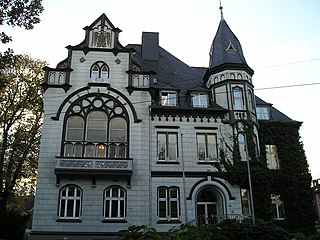
Haan is a town in the district of Mettmann, in North Rhine-Westphalia, Germany. It is situated at the western edge of the Bergisches Land, 12 km southwest of Wuppertal and 17 km east of Düsseldorf. In 1975, Gruiten was incorporated into Haan.

Barmen is a former industrial metropolis of the region of Bergisches Land, Germany, which merged with four other towns in 1929 to form the city of Wuppertal.
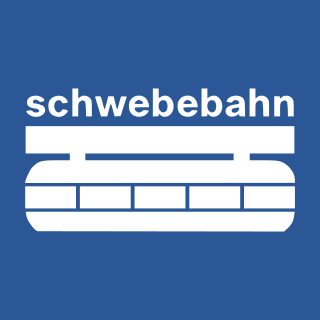
The Wuppertaler Schwebebahn is a suspension railway in Wuppertal, Germany. The line was originally called in German: Einschienige Hängebahn System Eugen Langen named after its inventor, Eugen Langen. It is the oldest electric elevated railway with hanging cars in the world. Being grade-separated, it is considered rapid transit.

Friedrich Bayer was the founder of what would become Bayer, a German chemical and pharmaceutical company. He founded the dyestuff factory Friedrich Bayer along with Johann Friedrich Weskott in 1863 in Elberfeld, a flourishing city in the early industrialised region of the Wuppertal or Wupper Valley.

Düsseldorf Hauptbahnhof is the main railway station of Düsseldorf, the state capital of North Rhine-Westphalia, Germany.
During the Second World War, the city of Wuppertal suffered numerous Allied air raids, primarily nighttime attacks from the Royal Air Force's Bomber Command during its Battle of the Ruhr bomber offensive. The largest raids were on the night of 29-30 May 1943, heavy enough to cause a firestorm, and on 24-25 June. The wartime-era German Feuerwehr fire brigades were ill-equipped to fight the fires. The RAF's airstrikes destroyed areas of Wuppertal's north-eastern Barmen, central Elberfeld and south-eastern Ronsdorf communities, mainly through incendiary area bombing, resulting in destructive firestorms. Other Allied aircraft also carried out numerous smaller air raids on Wuppertal. Overall, more than 6,500 people lost their lives during World War II in Wuppertal from such raids; 38 percent of the built-up urban area was destroyed.
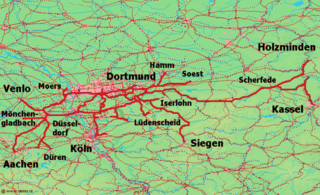
The Bergisch-Markisch Railway Company, also referred to as the Berg-Mark Railway Company or, more rarely, as the Bergisch-Markische Railway Company, was a German railway company that together with the Cologne-Minden Railway and the Rhenish Railway Company was one of the three (nominally) private railway companies that in the mid-19th century built the first railways in the Ruhr and large parts of today's North Rhine-Westphalia. Its name refers to Bergisches Land and the County of Mark.
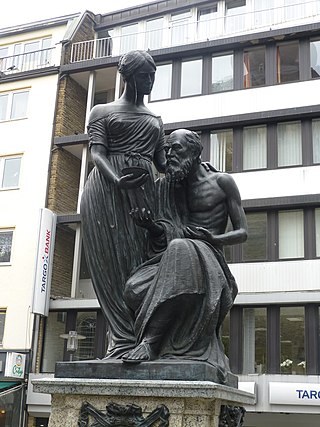
The Elberfeld system was a system for aiding the poor in 19th-century Germany. It was a success when it was inaugurated in Elberfeld in 1853 and was adopted by many other German cities, but by the turn of the century an increasing population became more than the Elberfeld system could handle, and it fell out of use.
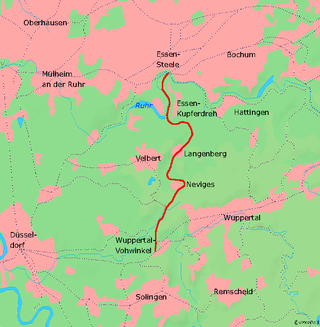
The Prince William Railway Company was an early horse-drawn railway in Germany. It was founded as the Deil Valley Railway Company in 1828 and renamed in 1831. It built a 820 mm narrow gauge line that ran for a Prussian mile along the Deilbach valley from a point near Kupferdreh Old Station in Hinsbeck, a suburb of Kupferdreh, to Nierenhof near Langenberg. This route is now part of the Wuppertal-Vohwinkel–Essen-Überruhr railway and served by Rhine-Ruhr S-Bahn line S9 trains.
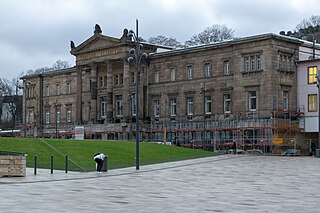
Wuppertal Hauptbahnhof is a railway station in the city of Wuppertal, just south of the Ruhr Area, in the German state of North Rhine-Westphalia. It is on the line between Düsseldorf/Cologne and Dortmund. The 1848 reception building is one of the oldest of its kind. The station was originally Elberfeld station and has been renamed several times since. Since 1992, it has been called Wuppertal Hauptbahnhof. Wuppertal Hauptbahnhof is also the site of lost luggage operations for Deutsche Bahn.

The Elberfeld–Dortmund railway is a major railway in the German state of North Rhine-Westphalia. It is part of a major axis for long distance and regional rail services between Wuppertal and Cologne, and is served by Intercity Express, InterCity, Regional Express, Regionalbahn and S-Bahn trains.
The Düsseldorf-Derendorf–Dortmund Süd railway is a partially closed line in the German state of North Rhine-Westphalia from Düsseldorf-Derendorf station to Dortmund South station. Parts of it are still busy, including two sections used for the Rhine-Ruhr S-Bahn.
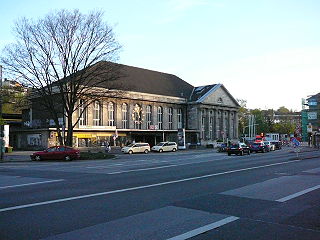
Wuppertal-Barmen station is a station in the city of Wuppertal in the German state of North Rhine-Westphalia on the Elberfeld–Dortmund railway. Its entrance building is protected as a monument. It was Barmen Hauptbahnhof prior to Barmen's incorporation in Wuppertal in 1929. Before the Second World War it was an important stop for express trains and had substantial freight traffic. Its importance declined after the war in favour of Oberbarmen and since the renaming of the Elberfeld station as Wuppertal Hauptbahnhof. The Opernhaus Wuppertal is nearby.
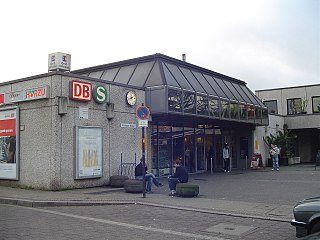
Wuppertal-Oberbarmen station is located in the city of Wuppertal in the German state of North Rhine-Westphalia. Historically, it served as a significant railway junction, connecting to four railway lines. Presently, the station is served by two remaining lines: the Dortmund–Wuppertal main line and the branch line to Solingen.

Wuppertal-Unterbarmen station is located in the German city of Wuppertal in the German state of North Rhine-Westphalia. It is on the Düsseldorf–Elberfeld line and is classified by Deutsche Bahn as a category 4 station.
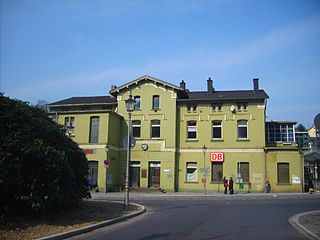
Velbert-Langenberg station is located in the city of Velbert in the German state of North Rhine-Westphalia. It is on the Wuppertal-Vohwinkel–Essen-Überruhr line and is classified by Deutsche Bahn as a category 5 station. It was built in 1847.
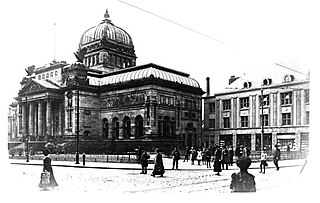
The Barmer Ruhmeshalle is a historic building in the Barmen district of the German town of Wuppertal, originally built as a hall of fame. It was officially known as the Kaiser Wilhelm- und Friedrich-Ruhmeshalle and later as the Haus der Jugend.
The Baumwollspinnerei Hammerstein was a cotton mill which had accompanying weaving sheds, located in the area now known as Wuppertal, Germany. It was the largest of its type in Bergisches Land and was owned by the Jung family between 1835 and 1869, when it also included a textile school.


















